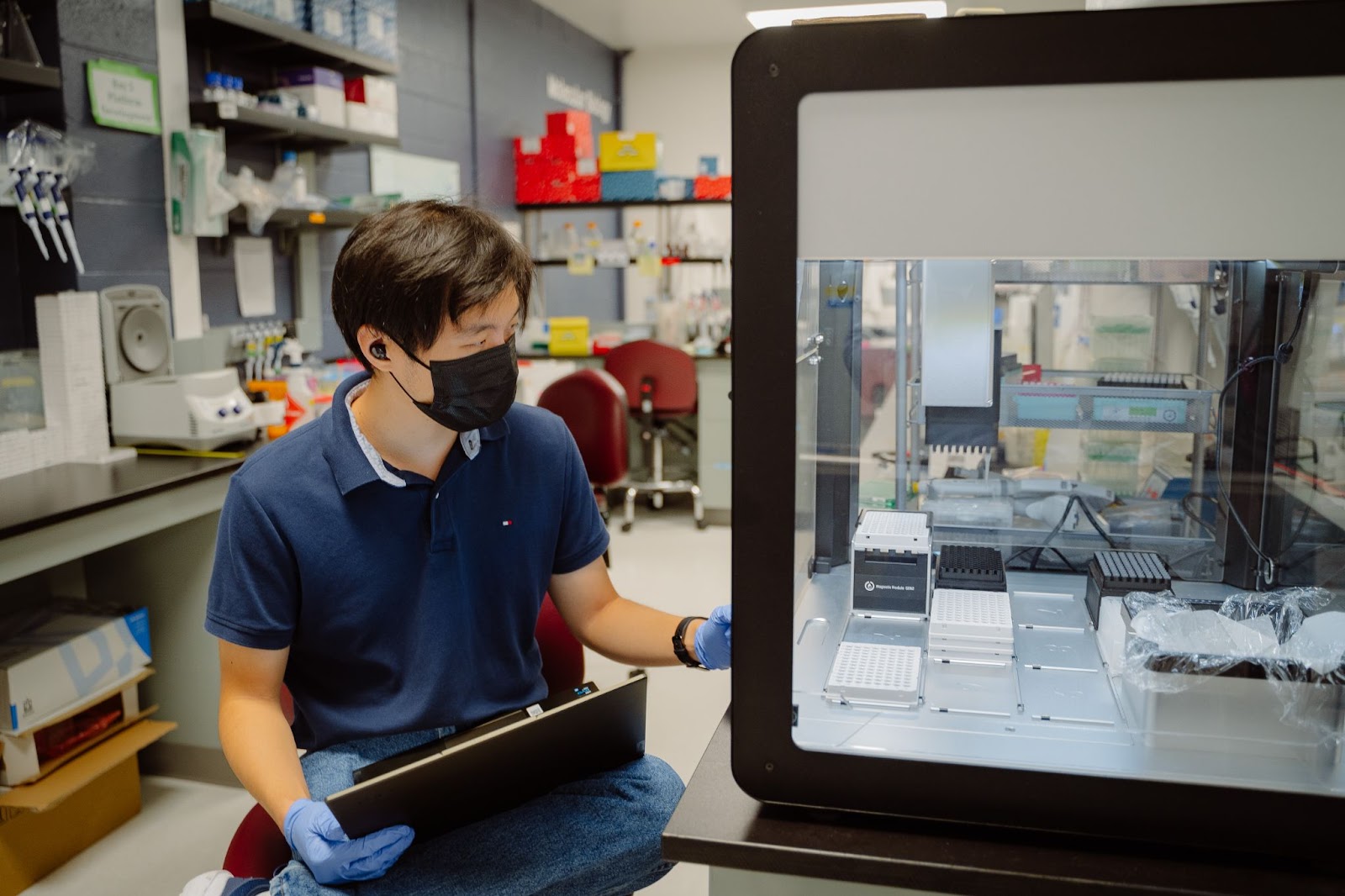-min%20(1).jpg)
Introducing Hypatia, our New Robotic Drug Hunter
Introducing Hypatia, our New Robotic Drug Hunter
At Octant we’re deploying high throughput biology and chemistry to build next-generation small molecule therapeutics. We use our Navigator platform to map the interactions between chemicals, genetics, and the cellular mechanisms of disease to build drugs that can modulate those mechanisms. Automation has played an important role as we’ve added capabilities to the Navigator platform.
In the early days of Octant we relied on rudimentary benchtop automation to speed up tasks like pipetting liquid from one plate into another. This simple equipment was sufficient for a while, but budding functional teams looking to add capabilities necessitated our adoption of more sophisticated instruments, such as the Echo and IDOT for high throughput chemistry and the Opentrons OT-2 to expedite molecular cloning. Acquisition of such equipment propelled us to screen potential drugs at a cadence of ~10,000 molecules/week in 2021. Although this figure may sound high, finding hits that are likely to become drugs is akin to looking for a needle in a haystack. And even with early hits in hand, more throughput was needed to engineer analogs of those hits to increase potency and other desired properties of the molecules. Increasing capacity could enable more “shots on goal,” both in terms of testing more compounds per screen and also running more drug programs. To this end, we set a 2022 goal to increase our screening throughput by tenfold within a year.

Scaling the Octant Navigator
When initially planning our screening expansion there were a few options we considered. The first was hiring more researchers to operate additional parallel versions of our existing Navigator setup. Using such an approach, our throughput would scale linearly with people and equipment. This actually might be an efficient way to scale the platform a few fold. Although it was not a longer term solution, since it would be quite expensive and operationally complex (space, consistency, increased process management, etc.) to scale by orders of magnitude, it would buy us more time before committing to a more fully automated platform. Committing to a more integrated automation platform would be an expensive decision that would be difficult to unwind.
Given we were relatively confident that we had figured out our core workflows and that we were ready to commit to scaling them, we decided it was time to focus on the longer term solution– onboarding an integrated automation system. To gain more domain expertise before making such a critical decision, we assembled an automation team that would soon turn our dreams of drug-screening robots into a reality. This team worked closely with scientists to understand their needs, trying to balance speed, efficiency, and reliability with a solution that would be modular enough to accommodate future innovation.
After evaluating many contenders, the automation team ultimately decided to purchase a system of Reconfigurable Automation Carts from Zymergen (now owned by Ginkgo Bioworks). The system (we’ve named our installation “Hypatia”) consists of a series of carts, each of which contains an instrument in an air-filtered enclosure, coupled to a robotic arm that is fixed with respect to the instrument’s position. This allows movement of the carts from time to time without having to endure the costly process of recalibrating centralized robotic arms to multiple positions (a common failure point in lab automation). A magnetic conveyor rail moves plates between the carts, enabling complex customizable routing between the instruments. Below you can see a few of the carts that we use for arraying chemical libraries into plates for single-point and dose-response screening.

The high reliability of the industrial automation setup means we can run Hypatia unsupervised well into the night, getting more mileage out of each day. The integration between instruments coupled with scheduling software also empowers us to run multiple experimental workflows simultaneously without human intervention. Finally, this option intrigued us because it is designed specifically to be modular– adding new instruments to Hypatia can be done rapidly while the rest of the system remains operational. Hypatia lets us run our long, locked-down workflows, while granting us the flexibility to test new capabilities and processes.
Hypatia’s initial configuration (pictured above) supported scientists by preparing plates for screening. By taking on this responsibility, Hypatia freed up Octonauts to perform other significant experiments, such as onboarding assays for new indications, finding orthogonal ways to characterize our hits, augmenting our repertoire of coupling chemistries, and running screening for additional drug programs. By the end of Q1 2023, Hypatia’s new configuration will also begin to offer scientists end-to-end screening. Once this is done we anticipate being able to screen over 200k compounds every week.
What does this new throughput mean?
Additional capacity allows us to run much larger screens across many more drug programs. In 2022 we increased our number of programs from two to seven, which would have been impossible without Hypatia. By traversing chemical space more quickly, our time to reach Go/No-Go decisions has reduced to only a couple of months from the start of hit identification. This allows us to take more therapeutic bets at a time, either independently or with external collaborators. With so many diseases unaddressed, the speed of drug discovery is of utmost importance and Hypatia is accelerating our plans to one day deliver relief to patients.
While the automation team played a crucial role in setting up Hypatia, this Herculean task was a broader team effort made possible by the support of our logistics, software, operations, and high throughput screening team. It has grown our confidence that Octonauts can rise to any challenge we meet. Now let’s go make some drugs!
Check out the video below for an in-depth look at Hypatia in action!

